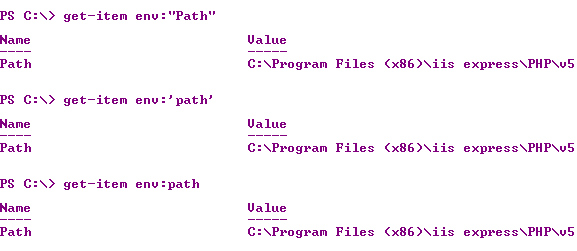If you have two or more versions of Power Shell on your computer it is possible to choose the one you want to run.
By default the highest version may be one that runs as in the present case on Windows 8.1 Professional (version 4.0 is installed in Windows 8.1 by default and Version 3.0 in Windows 8).
As described in the previous post, version 2.0 is also present.
You can run the version you want by the following command:
PS C:\>Powershell -version
This is how you run the version you want.
---------------
Windows PowerShell
Copyright (C) 2013 Microsoft Corporation. All rights reserved.
The next command displays the version number
PS C:\Users\Jayaram> $PSVersionTable.PSVersion
Major Minor Build Revision
----- ----- ----- --------
4 0 -1 -1
The following changes the version to 2.0. Note that there is no response.
PS C:\Users\Jayaram> PowerShell -version 2.0
Windows PowerShell
Copyright (C) 2009 Microsoft Corporation. All rights reserved.
The following displays the version after change
PS C:\Users\Jayaram> $PSVersionTable.PSVersion
Major Minor Build Revision
----- ----- ----- --------
2 0 -1 -1
PS C:\Users\Jayaram>
By default the highest version may be one that runs as in the present case on Windows 8.1 Professional (version 4.0 is installed in Windows 8.1 by default and Version 3.0 in Windows 8).
As described in the previous post, version 2.0 is also present.
You can run the version you want by the following command:
PS C:\>Powershell -version
This is how you run the version you want.
---------------
Windows PowerShell
Copyright (C) 2013 Microsoft Corporation. All rights reserved.
The next command displays the version number
PS C:\Users\Jayaram> $PSVersionTable.PSVersion
Major Minor Build Revision
----- ----- ----- --------
4 0 -1 -1
The following changes the version to 2.0. Note that there is no response.
PS C:\Users\Jayaram> PowerShell -version 2.0
Windows PowerShell
Copyright (C) 2009 Microsoft Corporation. All rights reserved.
The following displays the version after change
PS C:\Users\Jayaram> $PSVersionTable.PSVersion
Major Minor Build Revision
----- ----- ----- --------
2 0 -1 -1
PS C:\Users\Jayaram>



